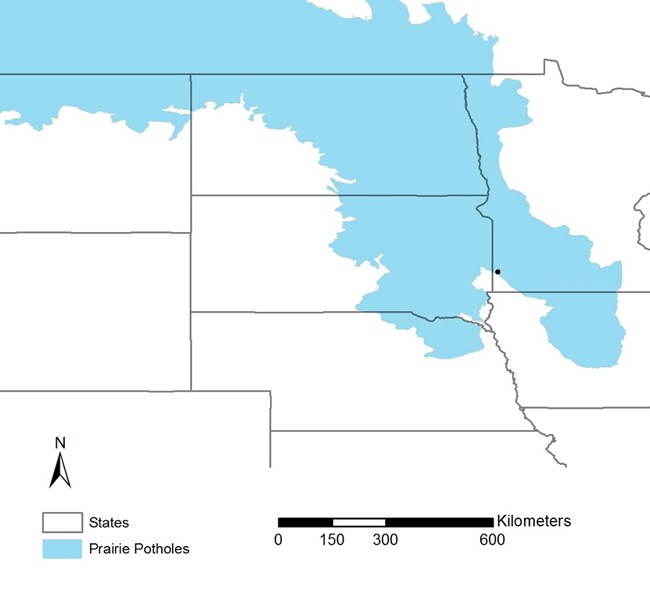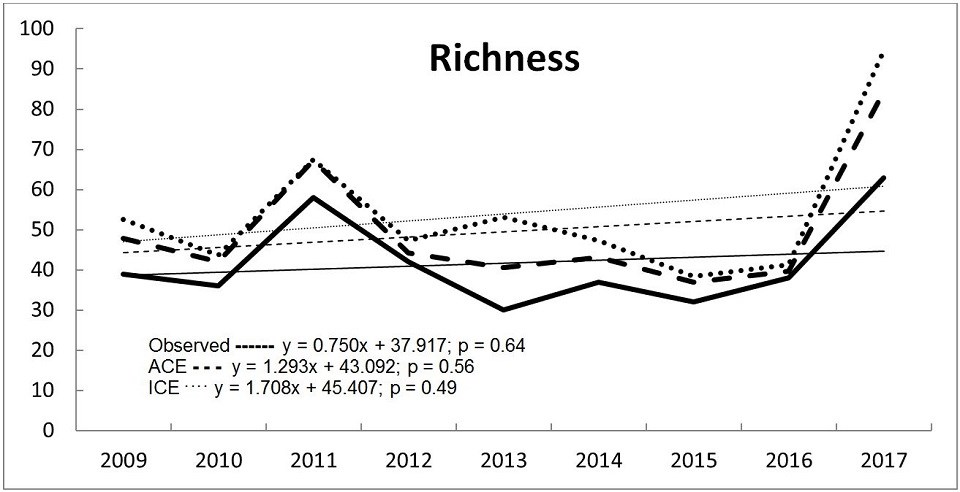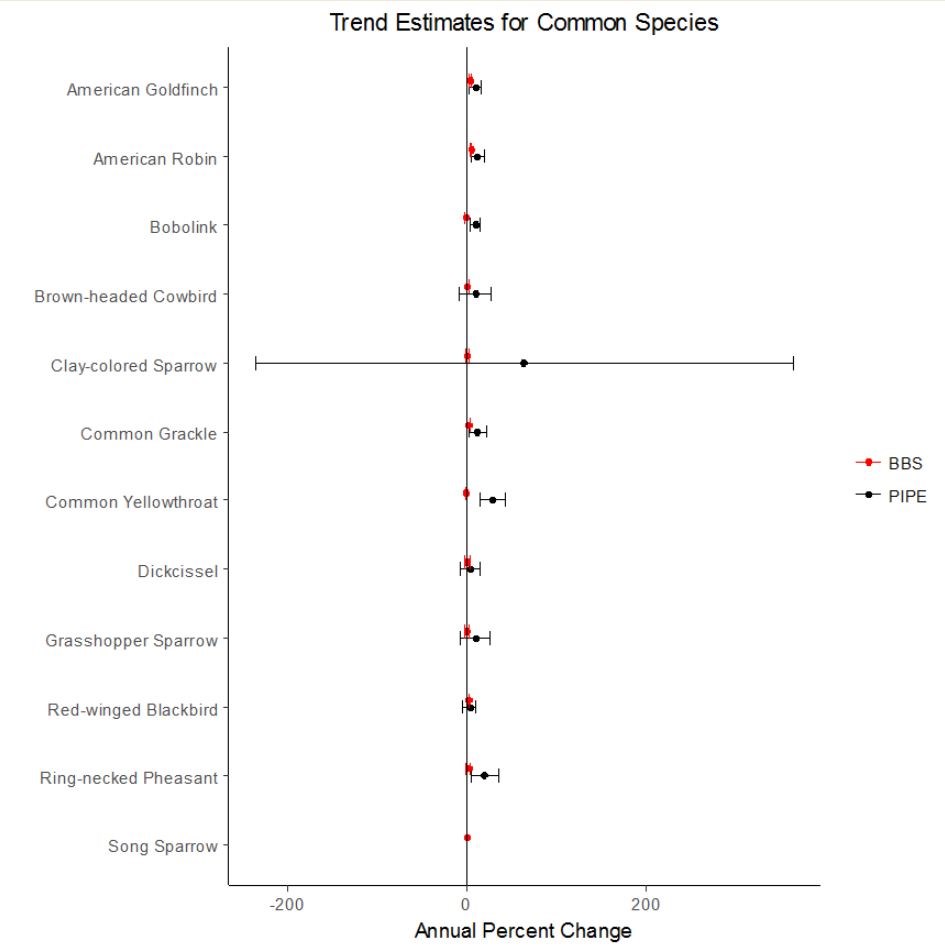Last updated: October 8, 2020
Article
Bird Community Monitoring at Pipestone National Monument

NPS-Photo

NPS-Photo
Scientists measure changes in bird numbers and habitat to determine the health of bird communities. They survey birds in the park during the breeding season. They also survey habitat structure and composition during this time. Together, the data helps researchers to determine responses of birds to their habitat. Regional surveys are also studied to determine local vs. regional trends.
| Common name | Species name | AOU code | Residency1 |
|---|---|---|---|
| American Crow | Corvus brachyrhynchos | AMCR | R |
| American Goldfinch | Spinus tristis | AMGO | R |
| American Restart | Setophaga ruticilla | AMRE | SR |
| American Robin | Turdus migratorius | AMRO | R |
| Baltimore Oriole | Icterus galbula | BAOR | SR |
| Bank Swallow | Riparia riparia | BANS | SR |
| Barn Swallow | Hirundo rustica | BARS | SR |
| Belted Kingfisher | Megaceryle alcyon | BEKI | SR |
| Black and White Warbler | Mniotilta varia | BAWW | SR |
| Black-capped Chickadee | Poecile atricapillus | BCCH | R |
| Blackpoll Warbler | Setophaga striata | BLPW | M |
| Black Tern | Chlidonias niger | BLTE | SR |
| Blue Jay | Cyanocitta cristata | BLJA | R |
| Blue-gray Gnatcatcher | Polioptila caerulea | BGGN | SR |
| Blue Grosbeak | Passerina caerulea | BLGR | SR |
| Blue-headed Vireo | Vireo solitarius | BHVI | M |
| Blue-winged Teal | Anas discors | BWTE | SR |
| Bobolink | Dolichonyx oryzivorus | BOBO | SR |
| Brewer’s Blackbird | Euphagus cyanocephalus | BRBL | O |
| Brown Thrasher | Toxostoma rufum | BRTH | SR |
| Brown-headed Cowbird | Molothrus ater | BHCO | SR |
| Canada Goose | Branta canadensis | CAGO | SR |
| Cedar Waxwing | Bombycilla cedrorum | CEDW | R |
| Cerulean Warbler | Setophaga cerulea | CERW | M |
| Chimney Swift | Chaetura pelagica | CHSW | SR |
| Chipping Sparrow | Spizella passerina | CHSP | SR |
| Clay-colored Sparrow | Spizella pallida | CCSP | SR |
| Common Grackle | Quiscula quiscula | COGR | SR |
| Common Nighthawk | Chordeiles minor | CONI | SR |
| Common Yellowthroat | Geothlypis trichas | COYE | SR |
| Cooper’s Hawk | Accipiter cooperii | COHA | R |
| Dickcissel | Spiza americana | DICK | SR |
| Double-crested Cormorant | Phalacrocorax auritus | DCCO | SR |
| Downy Woodpecker | Picoides pubescens | DOWO | R |
| Eastern Kingbird | Tyrannus tryannus | EAKI | SR |
| Eastern Meadowlark | Sturnella magna | EAME | O |
| Eastern Phoebe | Sayornis phoebe | EAPH | SR |
| Eastern Towhee | Pipilo erythrophthalmus | EATO | SR |
| European Starling | Sturnus vulgaris | EUST | R |
| Field Sparrow | Spizella pusilla | FISP | SR |
| Grasshopper Sparrow | Ammodramus savannarum | GRSP | SR |
| Gray Catbird | Dumetella carolinensis | GRCA | SR |
| Great Blue Heron | Ardea herodias | GBHE | SR |
| Great Crested Flycatcher | Myiarchus crinitus | GCFL | SR |
| Green Heron | Butorides virescens | GRHE | SR |
| Hairy Woodpecker | Picoides villosus | HAWO | R |
| Henslow’s Sparrow | Ammodramus henslowii | HESP | SR |
| Horned Lark | Eremophila alpestris | HOLA | R |
| House Finch | Haemorhous mexicanus | HOFI | R |
| House Sparrow | Passer domesticus | HOSP | SR |
| House Wren | Troglodytes aedon | HOWR | SR |
| Killdeer | Charadrius vociferus | KILL | SR |
| Lapland Longspur* | Calcarius lapponicus | LALO | WR |
| Least Bittern | Ixobrychus exilis | LEBI | SR |
| Least Flycatcher | Empidonax minimus | LEFL | SR |
| Mallard | Anas platyrhynchos | MALL | R |
| Marsh Wren | Cistothorus palustris | MAWR | SR |
| Mourning Dove | Zenaida macroura | MODO | R |
| Nashville Warbler | Leiothlypis ruficapilla | NAWA | M |
| Northern Flicker | Colaptes auratus | YSFL | R |
| Northern Harrier | Circus cyaneus | NOHA | R |
| Northern Rough-winged Swallow | Stelgidopteryx serripennis | NRWS | SR |
| Northern Shoveler | Anas clypeata | NSHO | SR |
| Orchard Oriole | Icterus spurius | OROR | SR |
| Red-tailed Hawk | Buteo jamaicensis | RTHA | R |
| Red-winged Blackbird | Agelaitus phoeniceus | RWBL | SR |
| Ring-necked Pheasant | Phasianus colchicus | RPHE | R |
| Rock Dove | Columba livia | RODO | R |
| Ruby-throated Hummingbird | Archilochus colubris | RTHU | M |
| Savannah Sparrow | Passerculus sandwichensis | SAVS | SR |
| Sedge Wren | Cistothorus platensis | SEWR | SR |
| Song Sparrow | Melospiza melodia | SOSP | R |
| Sora | Porzana carolina | SORA | SR |
| Swainson’s Hawk | Buteo swainsoni | SWHA | SR |
| Tennessee Warbler | Leiothlypis peregrina | TEWA | M |
| Tree Swallow | Tachycineta bicolor | TRES | SR |
| Turkey Vulture | Cathartes aura | TUVU | SR |
| Upland Sandpiper | Bartramia longicauda | UPSA | SR |
| Vesper Sparrow | Pooecetes gramineus | VESP | SR |
| Warbling Vireo | Vireo gilvus | WAVI | SR |
| Western Kingbird | Tyrannus verticalis | WEKI | SR |
| Western Meadowlark | Sturnella neglecta | WEME | SR |
| White-crowned Sparrow* | Zonotrichia leucophrys | WCSP | M |
| Wild Turkey | Meleagris gallopavo | WITU | R |
| Willow Flycatcher | Empidonax traillii | WIFL | SR |
| Wilson’s Warbler | Cardellina pusilla | WIWA | M |
| Wood Duck | Aix sponsa | WODU | SR |
| Yellow Warbler | Setophaga petechia | YWAR | SR |
| Yellow-breasted Chat | Icteria virens | YBCH | O |
| Yellow-headed Blackbird | Xanthocephalus xanthocephalus | YHBL | SR |
| Yellow-rumped Warbler | Setophaga coronata | MYWA | SR |
| Yellow-throated Vireo | Vireo flavifrons | YTVI | SR |
* Species recorded only while traveling between survey plots or at other times outside of 5-min survey periods.
¹ Residency status: SR = summer resident; R = year around resident; WR = winter resident; M = late season migrant; O = outside of normal range (Janssen et al. 2003).
Species names are valid and verified names taken from the Integrated Taxonomic Information System web site (ITIS 2017).

NPS
Scientists recorded 92 bird species in the park over the last 9 years. Eighty of the bird species are breeding species. Six of the bird species are of concern for the region. The Bobolink, Clay-colored Sparrow, and Common Grackle were common species. A total of 12 species were common enough to calculate trends in their numbers. Six of the species on the park had increasing numbers. The remaining species had stable populations. Within the region, four species had increasing numbers. One species had a declining population. The remaining species in the region had uncertain population trends. Most populations on the park are doing as well or better than the region. Unchanging species richness suggests habitat on the park has remained similar across years.

NPS
Bird population changes may reflect habitat management activities. For that reason scientists track changes in bird populations and habitat over time. This improves the parks efforts to manage habitat for birds. Preserving habitat for birds preserves entire ecosystems for the benefit of all species.
Visit the Pipestone National Monument Volunteer Bird Monitoring page.
Learn more about the Heartland Inventory & Monitoring Network.
Data in this report were collected and analyzed using methods based on established, peer-reviewed protocols and were analyzed and interpreted within the guidelines of the protocols.
